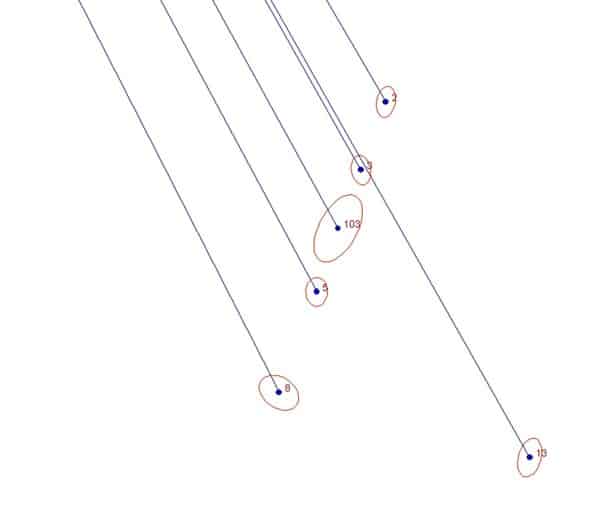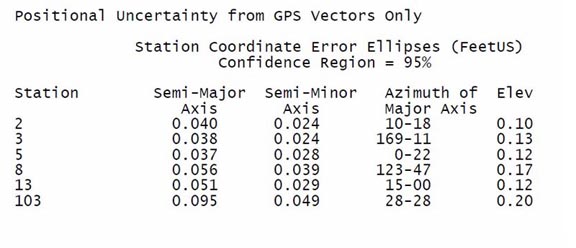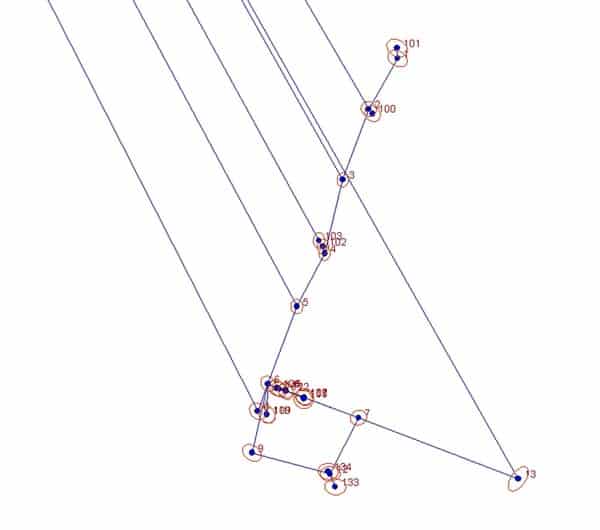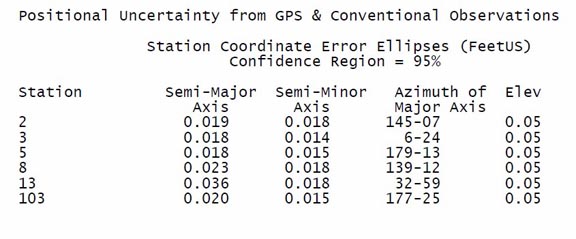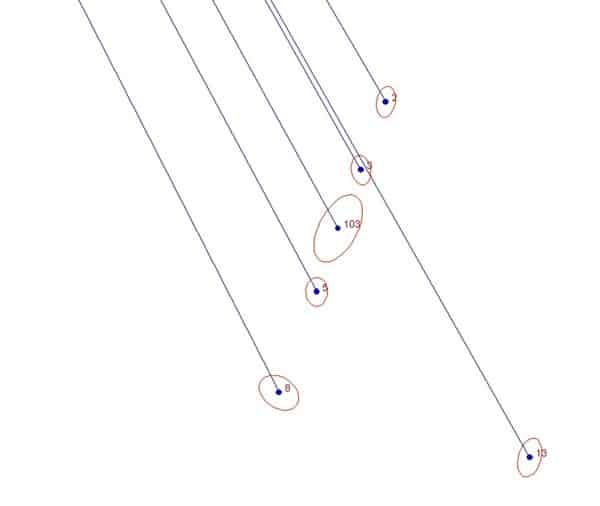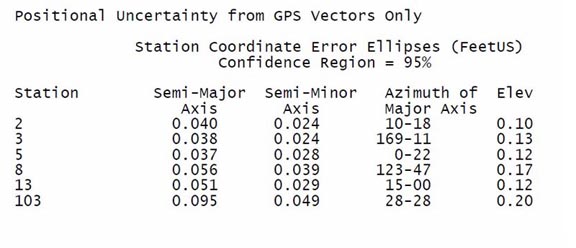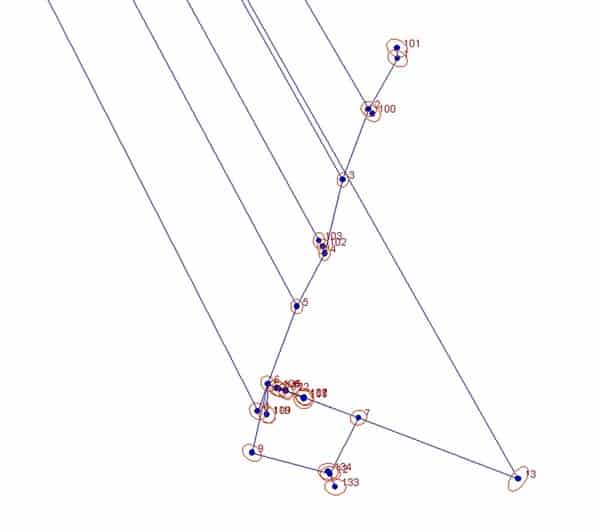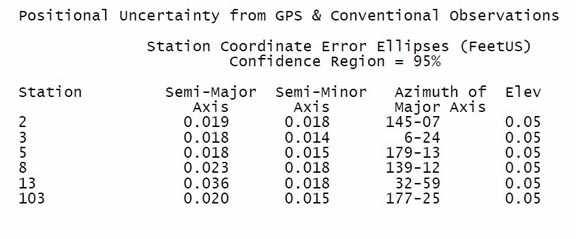For those who may benefit from the demonstration, here's an example of some control points positioned in an area about 2100 ft. x 1300 ft. in extent. The points all fall along urban streets with plenty of traffic and obstructions. The monuments themselves are punchmarks on spikes set with stamped aluminum washers in drillholes in concrete curbs and pavements.
This is what the uncertainties of the positions look like by GPS only:
So, just looking at the uncertainties of the individual GPS-derived positions, one might think that would be as good as things could get without adding more GPS vectors. However, running conventional measurements between them and adjusting both GPS vectors and conventional measurements in an LSA program like Star*Net makes a significant improvement.
The "magic" that reduces the uncertainties by roughly 50% from the GPS-only solution is from several GPS-derived positions being connected by ties with sufficiently small uncertainties in direction and distance.
yep, just about what we see combining conventional with GPS.
You are 2/3rds there setting urban control (although it looks like it's pivoted around a single point, guess as long as it's internally consistent.........) all you need now is the next set of measurements and you will have good control,,,,,,,,, are you planning to get them or is this all of it?
Hmm. For some reason, I'm not seeing the images that I posted with the OP of this thread. Here is what it should look like:
For those who may benefit from the demonstration, here's an example of some control points positioned in an area about 2100 ft. x 1300 ft. in extent. The points all fall along urban streets with plenty of traffic and obstructions. The monuments themselves are punchmarks on spikes set with stamped aluminum washers in drillholes in concrete curbs and pavements.
This is what the uncertainties of the positions look like by GPS only:
So, just looking at the uncertainties of the individual GPS-derived positions, one might think that would be as good as things could get without adding more GPS vectors. However, running conventional measurements between them and adjusting both GPS vectors and conventional measurements in an LSA program like Star*Net makes a significant improvement.
The "magic" that reduces the uncertainties by roughly 50% from the GPS-only solution is from several GPS-derived positions being connected by ties with sufficiently small uncertainties in direction and distance.
MightyMoe, post: 346978, member: 700 wrote: You are 2/3rds there setting urban control (although it looks like it's pivoted around a single point, guess as long as it's internally consistent.........) all you need now is the next set of measurements and you will have good control,,,,,,,,, are you planning to get them or is this all of it?
LOL! That "single point" is a CORS antenna at less than 10km. The GPS-derived postions include repeat occupations on points 2, 5, and 8 just to demonstrate that no systematic error of any consequence was present in one day's work. Otherwise, the conventional measurements provide more than adequate redundancy. Here is the output listing that gives the standard errors and residuals of the angles and distances, for example. Kindly disregard the extra places in the adjusted values that Star*Net generates.
Kent,
From your positional uncertainty I am assuming those are all independent observations. Had you one static OPUS-RS position to solve relative to the others, you should have met or exceeded your traverse precision without having to do the traverse. Then doing the traverse merely confirms your GPS work.
Even at 10km from a CORS I would want a static observation within my traverse.
I am also used to my GPS position heights being less than twice the horizontal and traverse heights being under 0.01'.
Paul in PA
An important feature is that the uncertainties become more uniform, and the ellipses more circular.
Kent doesn't do RTK. Those GPS vectors are all the product of static sessions. It may be a benefit to have vectors from a second and third CORS, which may be what you are driving at with OPUS-RS.
Yes, it makes the positional uncertainty much easier to describe with a "less than" statement.
Correct, although it's a mixture of session lengths. Some are only 5-minute occupations in a PPK segment that produced static solutions (and got checked for wild ones).
So, kinda staticish, RTK like base-rover survey to one point that may or may not have the correct coordinates on the base, if you do RTK from a broadcasting CORS there is no doubt that the coordinates being used are the correct ones, processing them this way one can only assume that they are imputed correctly in the file, I'm sure you checked that, but the way to prove it is to tie another CORS which is the great advantage of static over RTK, otherwise it's just like RTK which is a base-rover tie real time processed survey instead of taking it back to the office and processing.
But assuming the base coordinate is correct (even if it's not,,,,,,say it's 5' off it won't effect this set of numbers cause there is no independent tie beyond using the same base point over an over) then there is only one item left for a real control survey, and that's running levels, tie to bench marks and then we have something.
The survey will at least be tied down vertically, horizontally, real coordinates not so much without an independent check, but that really isn't concerning for this control I assume.
In the case of a CORS antenna, the surveyor who wants or needs to convince himself or herself that the folks at NGS actually publish the correct coordinates of the antenna can always submit the same day's file to OPUS for a solution. The time series on the CORS would turn up any wild movement, horizontal or vertical, though. There are things to worry about and then there are things to worry about. The stability of a major CORS site like TXAU doesn't strike me as much of an issue compared to other stuff.
my bad, didn't realize the NGS did the calcs
I would note that I have more and closer CORS than Kent does.
Kent should be able to get a 6 CORS OPUS-RS, 0.02'H and 0.04"V. Based on 5-6 minutes for the various occupations and travel, the OPUS-RS should be in the range of 1 hour. Hold your OPUS-RS position fixed and solve to your points and the closest CORS.
Paul in PA
I'm afraid that I don't get the advantage of a low-quality OPUS solution from a very short occupation. It might be interesting as an experiment, but for reliable production work, I much prefer processing the vector solutions myself in the sort of cluttered, obstructed environments that that project mostly had.
For baselines in the 10km and under range, as long as the CORS site is stable, using several CORS sites in a solution likewise seems more like wheel spinning.
Kent, here is a low quality OPUS solution as you say:
FILE: sam2335q.15o OP1449192227049
1008 NOTE: Antenna offsets supplied by the user were <=0. Coordinates
1008 returned will be for the antenna reference point (ARP).
1008
NGS OPUS-RS SOLUTION REPORT
========================
All computed coordinate accuracies are listed as 1-sigma RMS values.
For additional information: http://www.ngs.noaa.gov/OPUS/about.jsp#accuracy
USER: lplopresti@enter.net DATE: December 04, 2015
RINEX FILE: sam2335q.15o TIME: 01:32:42 UTC
SOFTWARE: rsgps 1.37 RS51.prl 1.99.2 START: 2015/12/01 16:00:00
EPHEMERIS: igr18732.eph [rapid] STOP: 2015/12/01 17:00:00
NAV FILE: brdc3350.15n OBS USED: 8028 / 8514 : 94%
ANT NAME: TRM57971.00 NONE QUALITY IND. 6.12/ 46.06
ARP HEIGHT: 0.000 NORMALIZED RMS: 0.376
REF FRAME: NAD_83(2011)(EPOCH:2010.0000) IGS08 (EPOCH:2015.91695)
X: -751969.764(m) 0.008(m) -751970.557(m) 0.008(m)
Y: -5463640.177(m) 0.017(m) -5463638.718(m) 0.017(m)
Z: 3193399.162(m) 0.005(m) 3193398.977(m) 0.005(m)
LAT: 30 14 20.44812 0.008(m) 30 14 20.46480 0.008(m)
E LON: 262 9 48.67594 0.009(m) 262 9 48.63912 0.009(m)
W LON: 97 50 11.32406 0.009(m) 97 50 11.36088 0.009(m)
EL HGT: 212.821(m) 0.016(m) 211.572(m) 0.016(m)
ORTHO HGT: 238.527(m) 0.020(m) [NAVD88 (Computed using GEOID12B)]
UTM COORDINATES STATE PLANE COORDINATES
UTM (Zone 14) SPC (4203 TX C)
Northing (Y) [meters] 3345842.967 3066145.856
Easting (X) [meters] 611952.846 940305.306
Convergence [degrees] 0.58601994 1.28602705
Point Scale 0.99975462 0.99996959
Combined Factor 0.99972121 0.99993617
US NATIONAL GRID DESIGNATOR: 14RPU1195245842(NAD 83)
BASE STATIONS USED
PID DESIGNATION LATITUDE LONGITUDE DISTANCE(m)
DG5769 TXTA TAYLOR CORS ARP N303351.193 W0972642.115 52104.5
DG5761 TXBS BASTROP CORS ARP N300646.244 W0971726.171 54406.2
DE6248 SGI1 SCHULTZ GROUP COO CORS ARP N294315.169 W0980851.693 64816.5
DG5763 TXBU BURNET CORS ARP N304501.641 W0981103.759 65808.4
DG9111 LCSM SMITHVILLE COOP CORS ARP N300030.431 W0970731.758 73128.6
DJ7872 TXSE SEGUIN CORS ARP N293527.013 W0975951.834 73520.7
DL3504 TXGZ GONZALES CORS ARP N293123.766 W0972621.004 88137.6
DM4151 TXBT BELTON CORS ARP N310157.518 W0972844.400 94424.7
DH3770 TXLL LLANO CORS ARP N304400.712 W0984042.905 97689.1
NEAREST NGS PUBLISHED CONTROL POINT
DN6089 SAM AUSTIN CORS ARP N301420.448 W0975011.323 0.0
This position and the above vector components were computed without any
knowledge by the National Geodetic Survey regarding the equipment or
field operating procedures used.
It is one hour from SAM2. The nine CORS range from 50Km to 100Km away. Six of them are 50-70Km away. I got the solution back 10 minutes after submitting.
I will resubmit the same file and ask for extended output and repost any interesting data I see.
Paul in PA
That's from a ONE HOUR file, though. To be comparable, you need a FIVE MINUTE occupation in an environment with loads of clutter, meaning signage, buildings, chain-link fences, and passing vehicles, including trucks and buses. I would expect that it would be a waste of time to try to get OPUS-RS solutions from five minutes of data under those conditions.
These are the residuals from the extended data for the solution I previously posted
Residuals of position determined by individual baselines from the final position
X Y Z East North Up
txta 0.007 -0.004 -0.003 0.008 -0.004 0.001
txbs -0.009 0.021 -0.010 -0.012 0.001 -0.022
sgi1 0.001 0.017 -0.010 -0.002 0.000 -0.020
txbu -0.002 0.017 0.000 -0.004 0.008 -0.014
lcsm 0.016 -0.011 -0.001 0.018 -0.006 0.007
txse 0.001 -0.025 -0.002 0.004 -0.014 0.020
txgz -0.001 0.001 0.003 -0.001 0.003 0.001
txbt -0.008 -0.001 0.002 -0.008 0.001 0.003
txll 0.002 0.025 0.001 -0.002 0.013 -0.021
I further excluded TXBS, LCSM, TXSE & TX11 and resubmitted. OPUS-RS still found 9 CORS albeit farther away but the solution got better:
FILE: sam2335q.15o OP1449197148846
1008 NOTE: Antenna offsets supplied by the user were <=0. Coordinates
1008 returned will be for the antenna reference point (ARP).
1008
NGS OPUS-RS SOLUTION REPORT
========================
All computed coordinate accuracies are listed as 1-sigma RMS values.
For additional information: http://www.ngs.noaa.gov/OPUS/about.jsp#accuracy
USER: lplopresti@enter.net DATE: December 04, 2015
RINEX FILE: sam2335q.15o TIME: 02:53:14 UTC
SOFTWARE: rsgps 1.37 RS54.prl 1.99.2 START: 2015/12/01 16:00:00
EPHEMERIS: igr18732.eph [rapid] STOP: 2015/12/01 17:00:00
NAV FILE: brdc3350.15n OBS USED: 8028 / 8514 : 94%
ANT NAME: TRM57971.00 NONE QUALITY IND. 15.95/ 46.07
ARP HEIGHT: 0.000 NORMALIZED RMS: 0.367
REF FRAME: NAD_83(2011)(EPOCH:2010.0000) IGS08 (EPOCH:2015.91695)
X: -751969.766(m) 0.007(m) -751970.559(m) 0.007(m)
Y: -5463640.169(m) 0.010(m) -5463638.710(m) 0.010(m)
Z: 3193399.160(m) 0.005(m) 3193398.975(m) 0.005(m)
LAT: 30 14 20.44819 0.005(m) 30 14 20.46486 0.005(m)
E LON: 262 9 48.67583 0.007(m) 262 9 48.63901 0.007(m)
W LON: 97 50 11.32417 0.007(m) 97 50 11.36099 0.007(m)
EL HGT: 212.813(m) 0.009(m) 211.565(m) 0.009(m)
ORTHO HGT: 238.519(m) 0.015(m) [NAVD88 (Computed using GEOID12B)]
UTM COORDINATES STATE PLANE COORDINATES
UTM (Zone 14) SPC (4203 TX C)
Northing (Y) [meters] 3345842.969 3066145.858
Easting (X) [meters] 611952.843 940305.303
Convergence [degrees] 0.58601993 1.28602703
Point Scale 0.99975462 0.99996959
Combined Factor 0.99972121 0.99993617
US NATIONAL GRID DESIGNATOR: 14RPU1195245842(NAD 83)
BASE STATIONS USED
PID DESIGNATION LATITUDE LONGITUDE DISTANCE(m)
DG5769 TXTA TAYLOR CORS ARP N303351.193 W0972642.115 52104.5
DE6248 SGI1 SCHULTZ GROUP COO CORS ARP N294315.169 W0980851.693 64816.5
DG5763 TXBU BURNET CORS ARP N304501.641 W0981103.759 65808.4
DL3504 TXGZ GONZALES CORS ARP N293123.766 W0972621.004 88137.6
DM4151 TXBT BELTON CORS ARP N310157.518 W0972844.400 94424.7
DH3770 TXLL LLANO CORS ARP N304400.712 W0984042.905 97689.1
DJ7862 TXBO BOERNE CORS ARP N294915.135 W0984511.923 99850.3
DO8863 TXC2 CAMERON CORS ARP N305235.392 W0965820.397 108942.7
DF4371 TXAN SAN ANTONIO RRP2 CORS ARP N292928.343 W0983435.880 109479.6
NEAREST NGS PUBLISHED CONTROL POINT
DN6089 SAM AUSTIN CORS ARP N301420.448 W0975011.323 0.0
Paul in PA
Kent,
You are missing my point.
You do one long occupation amidst your project points and solve those points from that OPUS-RS position. You also have that more precise point as a part of your traverse. That is where your project improvement comes from.
Paul in PA
Kent,
You won't get a solution from OPUS-RS for 5 minutes, but here is what a 10 minute solution looks like.
FILE: sam2335q1.15o OP1449198615363
9999 OPUS-RS DISCLAIMER OPUS-RS DISCLAIMER OPUS-RS DISCLAIMER
9999
9999 Your data file spans less than 0.01 days
9999 (14.4 minutes). OPUS-RS
9999 recommends a minimum of 15 minutes of data to obtain accurate
9999 positions. OPUS-RS will not attempt to process datasets under 0.005
9999 day (7.2 minutes)
9999
1008 NOTE: Antenna offsets supplied by the user were <=0. Coordinates
1008 returned will be for the antenna reference point (ARP).
1008
NGS OPUS-RS SOLUTION REPORT
========================
All computed coordinate accuracies are listed as 1-sigma RMS values.
For additional information: http://www.ngs.noaa.gov/OPUS/about.jsp#accuracy
USER: lplopresti@enter.net DATE: December 04, 2015
RINEX FILE: sam2335q.15o TIME: 03:12:21 UTC
SOFTWARE: rsgps 1.37 RS93.prl 1.99.2 START: 2015/12/01 16:00:00
EPHEMERIS: igr18732.eph [rapid] STOP: 2015/12/01 16:10:00
NAV FILE: brdc3350.15n OBS USED: 1323 / 1323 : 100%
ANT NAME: TRM57971.00 NONE QUALITY IND. 29.54/ 21.22
ARP HEIGHT: 0.000 NORMALIZED RMS: 0.349
REF FRAME: NAD_83(2011)(EPOCH:2010.0000) IGS08 (EPOCH:2015.91690)
X: -751969.762(m) 0.006(m) -751970.555(m) 0.006(m)
Y: -5463640.176(m) 0.017(m) -5463638.717(m) 0.017(m)
Z: 3193399.158(m) 0.009(m) 3193398.973(m) 0.009(m)
LAT: 30 14 20.44803 0.010(m) 30 14 20.46470 0.010(m)
E LON: 262 9 48.67601 0.006(m) 262 9 48.63919 0.006(m)
W LON: 97 50 11.32399 0.006(m) 97 50 11.36081 0.006(m)
EL HGT: 212.818(m) 0.017(m) 211.569(m) 0.017(m)
ORTHO HGT: 238.524(m) 0.021(m) [NAVD88 (Computed using GEOID12B)]
UTM COORDINATES STATE PLANE COORDINATES
UTM (Zone 14) SPC (4203 TX C)
Northing (Y) [meters] 3345842.965 3066145.853
Easting (X) [meters] 611952.848 940305.308
Convergence [degrees] 0.58601995 1.28602706
Point Scale 0.99975462 0.99996959
Combined Factor 0.99972121 0.99993617
US NATIONAL GRID DESIGNATOR: 14RPU1195245842(NAD 83)
BASE STATIONS USED
PID DESIGNATION LATITUDE LONGITUDE DISTANCE(m)
DG5769 TXTA TAYLOR CORS ARP N303351.193 W0972642.115 52104.5
DG5761 TXBS BASTROP CORS ARP N300646.244 W0971726.171 54406.2
DE6248 SGI1 SCHULTZ GROUP COO CORS ARP N294315.169 W0980851.693 64816.5
DG5763 TXBU BURNET CORS ARP N304501.641 W0981103.759 65808.4
DG9111 LCSM SMITHVILLE COOP CORS ARP N300030.431 W0970731.758 73128.7
DJ7872 TXSE SEGUIN CORS ARP N293527.013 W0975951.834 73520.7
DL3504 TXGZ GONZALES CORS ARP N293123.766 W0972621.004 88137.6
DM4151 TXBT BELTON CORS ARP N310157.518 W0972844.400 94424.7
DH3770 TXLL LLANO CORS ARP N304400.712 W0984042.905 97689.1
NEAREST NGS PUBLISHED CONTROL POINT
DN6089 SAM AUSTIN CORS ARP N301420.448 W0975011.323 0.0
Paul in PA
I think you're neglecting the detail that all of the control points positioned were well under 10km from TXAU and the sky visibility was much better at TXAU than anywhere within the bounds of the project. Now if the distance to TXAU had been more than 30km and their had been an optimal location topark a base receiver unattended, the plan you laid out would be efficient.
Think about it. If you were surveying something two blocks from TXAU, would you follow the same scheme? Obviously not. So what is the cut-off distance, then? Well under 10km (the longest vector to TXAU in my example was 7.7km) is functionally the same as two blocks.
